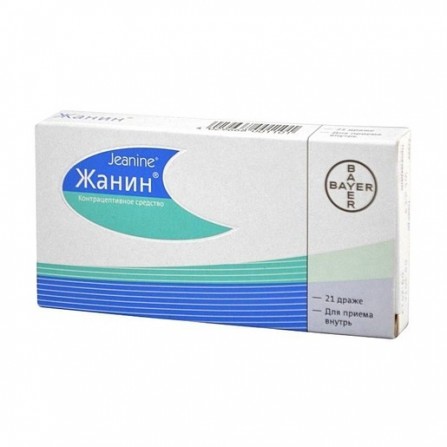More info
Active ingredients
Dienogest + Ethinyl Estradiol
Release form
Dragee
Composition
In 1 tablet: Ethambutol hydrochloride 400 mg. Adjuvants: microcrystalline cellulose - 12 mg, croscarmellose sodium - 40 mg, copolyvidone - 16 mg, macrogol 6000 - 12 mg, lactose - 33.4 mg, crospovidone - 1 mg, calcium phosphate acidic - 37.4 mg, magnesium stearate - 4 mg, colloidal silicon dioxide (colloidal silicon anhydride) - 4 mg.
Pharmacological effect
Ethambutol is a chemotherapeutic agent with a bacteriostatic effect on typical and atypical mycobacterium tuberculosis. The mechanism of action of the drug is associated with rapid penetration into the cell, where lipid metabolism is disturbed, RNA synthesis, magnesium and copper ions are bound, the structure of ribosomes is disturbed, and protein synthesis in bacterial cells. It affects the intracellular and extracellular types of bacteria. About 1% of patients have primary drug resistance. Ethambutol is well absorbed in the lung tissue and can reach a concentration of 5-9 times higher than in serum; penetrates well into many tissues and organs. Intracellular concentration in erythrocytes is 2 times higher than in serum.
Pharmacokinetics
Ethambutol is rapidly and 80% absorbed from the digestive tract. The minimum inhibitory concentration is 1 mg / ml. After ingestion of a single dose of 25 mg / kg of body weight after 2-4 hours, Cmax in serum 2-5 μg / ml is reached, after 24 hours the concentration is less than 1 μg / ml. 30% is bound to plasma proteins. Ethambutol is metabolized in the liver to derivatives of dicarboxylic acid. T1 / 2 is 3-4 hours, and in case of kidney failure it is extended up to 8 hours. Within 24 hours, more than 50% of the dose is excreted in the urine unchanged, and 8-15% in the form of inactive metabolites. About 20-22% of the initial dose of the drug is excreted in the feces unchanged. Ethambutol penetrates through the placenta. In the blood of the fetus, the concentration of ethambutol with leaves about 30% of the concentration of the drug in the mother’s blood.
Indications
Pulmonary tuberculosis; extrapulmonary tuberculosis.
Contraindications
Hypersensitivity to the drug; - inflammation of the optic nerve; - cataract; - diabetic retinopathy; - inflammatory eye diseases; - severe renal failure; - gout; - pregnancy; - lactation; - children under 13 years of age.
Use during pregnancy and lactation
The use of the drug is contraindicated in pregnancy and lactation.
Dosage and administration
Adults: in the initial period of treatment: 15 mg / kg of body weight / day - single dose; continuous treatment: usually 20 mg / kg of body weight / day. The dose can be increased to 30 mg / kg of body weight per day (but not more than 2.0 g) in the initial period of treatment, with the relapse of the disease, with the resistance of Koch sticks to other anti-tuberculosis drugs. Children from the age of 13 are prescribed at the rate of 15-25mg / kg of body weight (but not more than 1.0 g). The full course of treatment lasts 9 months. In case of renal diseases, the dose depends on the degree of renal failure, an indicator of which is creatinine clearance (CC). QC (ml / min) Daily dose over 100 20 mg / kg bw / day 70-100 15 mg / kg mt / sugne 70 10 mg / kg mt / sutpri hemodialysis 5 mg / kg mt / sutv day dialysis 7 mg / kg mt / sut patients who have previously taken drugs with tuberculostatic effect, resistance bacteria develops more often. In such cases, ethambutol should be taken with at least one or two anti-tuberculosis drugs that the patient has not taken before, and against which bacterial resistance is not marked. Isoniazid, para-aminosalicylic acid (PAS) is used in combination therapy with ethambutol, streptomycin, cycloserine, pyrazinamide and ethionamide.
Side effects
Retrobulbar inflammation of the optic nerve, unilateral or bilateral (weakening of visual acuity, impaired color sensation, the presence of a central or peripheral scotoma, limitation of the visual field). The occurrence of visual impairment depends on the duration of treatment and existing diseases of the eyeball. If they occur, treatment with ethambutol should be discontinued. Changes in vision are usually reversible, after cessation of treatment disappear in a few weeks, in some cases in a few months. In exceptional cases, changes in the eyeball are irreversible due to optic nerve atrophy; - allergic reactions: skin rash, pruritus, joint pain, fever, leukopenia; - gastrointestinal disorders; metallic taste in the mouth, nausea and vomiting, abdominal pain, lack of appetite; - headaches and dizziness, confusion, orientation disorder, hallucinations, convulsions; - an increase in serum uric acid levels, the appearance of uric acid diathesis.
Overdose
Treatment: induce vomiting, gastric lavage.
Interaction with other drugs
Aluminum hydroxide reduces the absorption of ethambutol from the digestive tract. Ethambutol alters the metabolism of some trace elements, mainly zinc.
special instructions
In patients with renal insufficiency, the dose of ethambutol should be reduced due to the accumulation of the drug in the body. Before starting treatment with ethambutol, ophthalmologic monitoring should be performed periodically: examination of the fundus of the eye, visual fields, visual acuity and color perception. It is recommended to periodically monitor liver, kidney and general blood tests. Effect on ability to drive vehicles and control mechanismsIz due to the possibility of visual impairment ( decrease in visual acuity, limitation of the visual field, disorder of color perception in relation to green and red color) during the treatment with ethambutol should not be dit machines and maintain the moving mechanical equipment.






